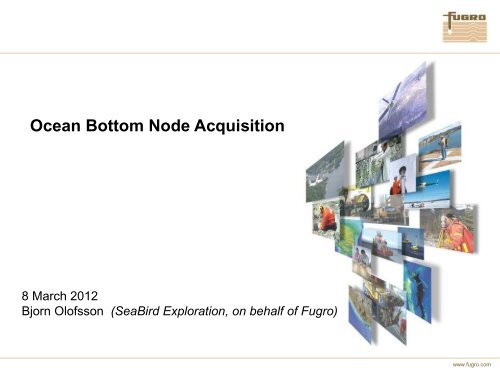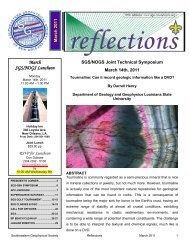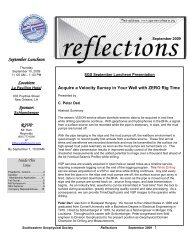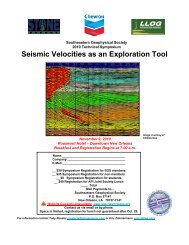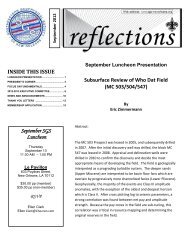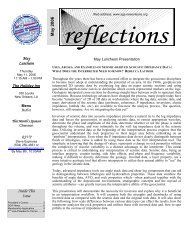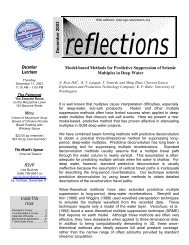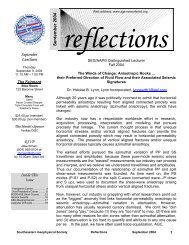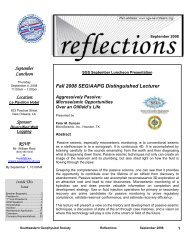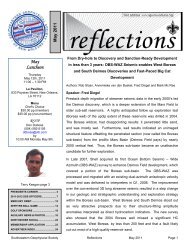Ocean Bottom Node Acquisition
Ocean Bottom Node Acquisition
Ocean Bottom Node Acquisition
You also want an ePaper? Increase the reach of your titles
YUMPU automatically turns print PDFs into web optimized ePapers that Google loves.
<strong>Ocean</strong> <strong>Bottom</strong> <strong>Node</strong> <strong>Acquisition</strong><br />
8 March 2012<br />
Bjorn Olofsson (SeaBird Exploration, on behalf of Fugro)<br />
www.fugro.com
<strong>Ocean</strong> <strong>Bottom</strong> <strong>Node</strong> <strong>Acquisition</strong> – What is it?<br />
4 component seismic sensor:<br />
3 geophones (XYZ) - also MEMS or optical for OBC<br />
1 hydrophone<br />
www.fugro.com
Outline<br />
• OBN <strong>Acquisition</strong> – Why is it done?<br />
• Equipment and node operation<br />
• Full azimuth survey<br />
• Data processing<br />
www.fugro.com
OBN <strong>Acquisition</strong><br />
Why is it done?<br />
www.fugro.com
OBN <strong>Acquisition</strong> – Why is it done?<br />
Atlantis field, GoM<br />
Complex imaging with full<br />
azimuth broad band data<br />
Beaudoin, SEG 2010<br />
www.fugro.com
OBN <strong>Acquisition</strong> – Why is it done?<br />
Atlantis field, GoM<br />
High resolution both vertically<br />
and laterally<br />
Howie et al, SEG 2008<br />
www.fugro.com
OBN <strong>Acquisition</strong> – Why is it done?<br />
Base line survey 4D difference<br />
Mars field, GoM<br />
4D Repeatability<br />
“Time-lapse noise measurements [...] are among<br />
the lowest in BP’s experience even when<br />
compared to permanent installation surveys.”<br />
Atlantis field, GoM Reasnor et al, SEG 2010<br />
“…high repeatability with a NRMS of around 6%.“ Stopin et al, EAGE 2011<br />
www.fugro.com
OBN <strong>Acquisition</strong> – Why is it done?<br />
Dalia field, Angola<br />
Infill under obstructions,<br />
congested oilfields<br />
www.fugro.com
OBN <strong>Acquisition</strong> – Why is it done?<br />
Drilling ship<br />
?<br />
FPSO (=Floating Production,<br />
Storage and Offloading unit)<br />
Offloading buoy<br />
Infill under obstructions,<br />
congested oilfields<br />
..another FPSO<br />
Supply boat Hugin Explorer<br />
www.fugro.com
OBN <strong>Acquisition</strong> – Why is it done?<br />
110°F<br />
Infill under obstructions,<br />
congested oilfields<br />
Source array<br />
firing<br />
www.fugro.com
OBN <strong>Acquisition</strong> – Why is it done?<br />
• <strong>Node</strong>s can be hand-placed almost anywhere<br />
• Passive recording, long offsets...<br />
• <strong>Ocean</strong> bottom nodes can carry many types of sensors<br />
Deep water,<br />
Unconventional methods<br />
OBN unit<br />
www.fugro.com
OBN <strong>Acquisition</strong> – Why is it done?<br />
Lomond field, North Sea<br />
Alba field, North Sea<br />
PP PS<br />
Grane field, North Sea<br />
Converted wave<br />
imaging<br />
Shown are classic OBC examples<br />
Beaudoin, SEG 2010<br />
Fjellanger et al, SEG 2006<br />
www.fugro.com
Why Converted Waves?<br />
PP AVO inversion P impedance<br />
PS AVO inversion Shear impedance<br />
PP & PS = Improved reservoir<br />
characterisation<br />
..also better handle on density. PP<br />
PS<br />
Strong shear<br />
impedance contrast<br />
from lithology change<br />
within reservoir zone.<br />
Kvitebjorn field, North Sea<br />
Ao & Areklett, TLE 2010<br />
www.fugro.com
Why Converted Waves?<br />
PP reflection, isotropic NMO correction<br />
Offset/Angle of incidence<br />
PS reflection, isotropic NMO correction<br />
PP & PS = Better anisotropic velocity<br />
model building<br />
Double Scan<br />
Note polarity reversal at<br />
critical angle<br />
Epsilon<br />
PP<br />
PS<br />
PP & PS<br />
Delta<br />
www.fugro.com
OBN <strong>Acquisition</strong><br />
Equipment and node operation<br />
www.fugro.com
OBN Equipment – <strong>Node</strong>s<br />
Option 1: Throw node overboard, let it float up by itself<br />
…illustration of node equipment from various vendors (& academia)<br />
• Typically glass or titanium sphere<br />
• Disposable heavy anchor<br />
• Internal or external sensor package<br />
• Mostly used for academic research or refraction lines EM node<br />
www.fugro.com
OBN Equipment – <strong>Node</strong>s<br />
Option 2: Hand-place node, pick it up manually<br />
…illustration of node equipment from various vendors<br />
• <strong>Node</strong> can be custom shaped<br />
• Recorder in cylindrical pressure vessels<br />
• Internal or external sensor package<br />
• Mostly used for commercial 3D surveys<br />
www.fugro.com
OBN Technology – Vessel and equipment<br />
Hugin Explorer – <strong>Node</strong>/Source/ROV vessel<br />
ROV<br />
Dual source capability<br />
<strong>Node</strong> storage capacity: 1200+<br />
Second ROV<br />
<strong>Node</strong> deck<br />
• Usually operates in dual-boat mode with a separate source<br />
vessel<br />
• In one survey the Hugin operated alone, deploying/retrieving<br />
nodes AND shooting while towing a 600m mini-streamer<br />
<strong>Node</strong> and sensors<br />
3 geophones (8Hz)<br />
1 hydrophone (1.5Hz analogue low cut)<br />
2 inclinometers<br />
Low frequency gain compared to other systems:<br />
www.fugro.com
OBN Equipment – <strong>Node</strong> Handling<br />
ROV <strong>Node</strong> basket<br />
www.fugro.com
OBN Operation – <strong>Node</strong> Placement<br />
www.fugro.com
OBN Operation – <strong>Node</strong> Placement<br />
Unperturbed<br />
soil<br />
Sensor skirt<br />
(cutaway view)<br />
“Added mass”<br />
contribution<br />
from soil<br />
www.fugro.com
OBN Operation – <strong>Node</strong> QC<br />
• Recorder status<br />
• Battery status<br />
• Hard disk status<br />
• Power usage<br />
• Tilt values<br />
• Seismic data RMS<br />
amplitudes<br />
• ...various other system<br />
information<br />
Acoustic modem communication<br />
between OBN and vessel<br />
www.fugro.com
OBN <strong>Acquisition</strong><br />
Full azimuth survey<br />
www.fugro.com
OBN <strong>Acquisition</strong> – Full azimuth survey<br />
Basic node survey design consists of regular node grid and encompassing shot grid.<br />
Illustration of contributing receivers/shots for two example bins:<br />
Centre bin Corner bin<br />
Shot area<br />
<strong>Node</strong> area<br />
Bin<br />
Contributing<br />
shot locations<br />
Shot area<br />
<strong>Node</strong> area<br />
Contributing<br />
node locations<br />
Bin<br />
www.fugro.com
OBN <strong>Acquisition</strong> – Full azimuth survey<br />
Rose diagram – Offset/azimuth fold:<br />
(similar OBN<br />
survey)<br />
Poor near<br />
offset fold??<br />
Offset fold diagram for the 2 example bins:<br />
www.fugro.com
OBN <strong>Acquisition</strong> – Full azimuth survey<br />
OBN offset/azimuth distribution is best viewed in common-offset vector tiles (OVTs).<br />
For every CMP bin, contributing shot-receiver pairs are evenly distributed on a regular<br />
inline/crossline offset grid. Pre-stack migration is best performed in OVTs.<br />
Centre bin<br />
Even offset<br />
distribution in<br />
every azimuth<br />
direction<br />
Corner bin<br />
Within the limits of survey area, every CMP<br />
bin has one trace in each offset vector tile.<br />
www.fugro.com
OBN <strong>Acquisition</strong> – Full azimuth survey<br />
Centre bin<br />
Corner bin<br />
Size of OVT is governed by node spacing<br />
Size of CMP bin is governed by shot spacing<br />
www.fugro.com
OBN <strong>Acquisition</strong><br />
Data Processing<br />
www.fugro.com
Continuous recorded data<br />
DC shift<br />
• Active shots need to be extracted from<br />
continuous record, using shot time<br />
• Shot time needs to be mapped to time of<br />
internal clock<br />
• Clocks used in OBNs are very accurate, but<br />
can still drift by several 10ms per month<br />
• New clocks only drift ~0.1ms per month<br />
Active shooting<br />
www.fugro.com
OBN Data processing – Spectral analysis<br />
Electrical<br />
“1/f” noise<br />
<strong>Ocean</strong><br />
wave noise<br />
Active shot energy.<br />
Ripples due to bubble<br />
Decay due to<br />
sensor responses<br />
and diminishing<br />
shot energy<br />
www.fugro.com
OBN Data processing<br />
Raypath geometry for one node/receiver gather:<br />
Pre-processing is done mostly in<br />
3D receiver gather domain.<br />
www.fugro.com
OBN Data processing – Raw data example<br />
Example raw receiver gather, deep water (~1km)<br />
X Y Z Hydrophone<br />
Zero offset<br />
PS<br />
converted<br />
waves<br />
P-wave<br />
reflection<br />
Direct arrival<br />
First water<br />
bottom multiple<br />
Second?<br />
Shear noise<br />
Bubble<br />
www.fugro.com
OBN Data processing – Multiple path imaging<br />
Conventional imaging<br />
Primary reflections, up-going wavefield<br />
Multiple path imaging<br />
Receiver side multiple, down-going wavefield<br />
www.fugro.com
OBN Data processing – P-wave imaging<br />
Essential data processing steps (fast-track)<br />
Pre-conditioning<br />
Noise attenuation<br />
PZ calibration<br />
Source designature<br />
Vz noise removal<br />
Wavefield<br />
separation<br />
Up/down decon<br />
TTI PSDM<br />
Radon demultiple<br />
Mute & Stack<br />
Post-stack<br />
processing<br />
<strong>Acquisition</strong>-related corrections:<br />
Positions, clock drift, tides…<br />
Seismic interference, ground roll<br />
(shallow water)<br />
Match hydrophone and geophone<br />
At least: Remove bubble oscillations<br />
Shear induced noise on Z component<br />
Separate into up- and downgoing<br />
energy, process separately<br />
Apply to upgoing energy<br />
Kirchhoff migration, using existing<br />
velocity field. Normal/multiple path<br />
Q compensation<br />
Advanced data processing steps<br />
Surface consistent<br />
processing<br />
Timing corrections<br />
3D SRME<br />
Offset vector tiles<br />
Interpolation /<br />
regularisation ?<br />
Anisotropic velocity<br />
model building<br />
RTM / Kirchhoff ?<br />
Azimuthal velocity<br />
correction<br />
..more generally:<br />
Surface consistent scaling,<br />
deconvolution, statics<br />
Advanced tidal and water<br />
velocity corrections<br />
Apply to downgoing energy<br />
Binning<br />
• Use 3D methods (noise attenuation..)<br />
• Integration of well data<br />
• Attention to details<br />
www.fugro.com
OBN Data processing – Multiple path imaging<br />
Conventional imaging<br />
Primary reflections, up-going wavefield<br />
Multiple path imaging<br />
Receiver side multiple, down-going wavefield<br />
Same aperture<br />
Wider aperture<br />
…from Dash et al (2009)<br />
www.fugro.com
OBN Data processing – Multiple path imaging<br />
Illustration from single 16-node line mini 2.5D survey (essentially 2D geometry)<br />
Upgoing migration Downgoing “mirror” migration<br />
processed by Geokinetics<br />
www.fugro.com
OBN Data processing – Low frequency content<br />
X Z ± 25km P<br />
1Hz - 2Hz<br />
X Z P<br />
3Hz - 4Hz<br />
X Z P<br />
Raw data, band-pass<br />
filtered, T<br />
2Hz - 3Hz<br />
X Z P<br />
1 gain<br />
4Hz - 5Hz<br />
www.fugro.com
OBN Data processing – Low frequency content<br />
1Hz - 2Hz<br />
3Hz - 4Hz<br />
2Hz - 3Hz<br />
Fully migrated 2D section,<br />
band-pass filtered<br />
4Hz - 5Hz<br />
Basalt layer<br />
1Hz - 20Hz<br />
..different scaling<br />
www.fugro.com
OBN <strong>Acquisition</strong> – Summary<br />
Upsides<br />
• Operationally efficient in presence of…<br />
‒ Surface obstructions (impeding use of towed streamer)<br />
‒ Seabed obstructions, rugged seafloor (impeding use of ocean bottom cables/OBC)<br />
• Full azimuth: Full & even surface azimuth/offset distribution<br />
• Vector fidelity: Ideal sensor coupling, decoupled sensor, no distortion due to instrument<br />
• High resolution: Naturally rich in low frequencies, no compromise at high end<br />
• Low ambient noise: Swell/flow noise (streamer), water current noise (OBC)<br />
• 4D repeatability: Repeatability of positions, and of final processed data (low NRMS)<br />
• Full elastic wavefield recording: 4 component sensor, P- and S-wave arrivals<br />
• Continuous recording: Passive seismic monitoring & analysis<br />
Downsides<br />
• Autonomous recording<br />
‒ Requires high fidelity clock drift correction<br />
‒ <strong>Node</strong> reliability is crucial<br />
• Sparse receivers<br />
‒ Resolved by multiple (mirror) imaging, but problematic for converted waves<br />
• Survey time & cost<br />
‒ Needs good evaluation of added value<br />
www.fugro.com
Thank You<br />
www.fugro.com
Spectral analysis<br />
Shot fired<br />
5<br />
1<br />
6<br />
Recorder noise<br />
ROV placing node at<br />
5m distance<br />
2<br />
Continuous data spectra – 4 minute traces<br />
X Component<br />
Seismic<br />
interference<br />
4<br />
Test shots<br />
8<br />
Ship<br />
7<br />
Shot lines<br />
<strong>Ocean</strong> wave<br />
noise<br />
3<br />
www.fugro.com
Spectral analysis<br />
Shot fired<br />
Recorder noise<br />
ROV placing node at<br />
5m distance<br />
Continuous data spectra – 4 minute traces<br />
Y Component<br />
Seismic<br />
interference<br />
Test shots<br />
Ship<br />
Shot lines<br />
<strong>Ocean</strong> wave<br />
noise<br />
www.fugro.com
Spectral analysis<br />
Shot fired<br />
ROV hoisted<br />
on deck<br />
Recorder noise<br />
ROV placing node at<br />
5m distance<br />
Continuous data spectra – 4 minute traces<br />
Z Component<br />
Seismic<br />
interference<br />
Test shots<br />
Ship<br />
Shot lines<br />
<strong>Ocean</strong> wave<br />
noise<br />
www.fugro.com
Spectral analysis<br />
Shot fired<br />
ROV hoisted<br />
on deck<br />
Recorder noise<br />
Continuous data spectra – 4 minute traces<br />
Hydrophone<br />
Seismic<br />
interference<br />
Test shots<br />
Ship<br />
Shot lines<br />
<strong>Ocean</strong> wave<br />
noise<br />
www.fugro.com
Spectral analysis<br />
Continuous data spectra – 4 minute traces<br />
Hydrophone<br />
Earthquake/<br />
Seaslide<br />
Same spectrum, zoomed in to 0-0.7Hz<br />
5 hours of recording 5 hours of recording<br />
www.fugro.com
OBN Survey – <strong>Node</strong> and source area<br />
O/W contact<br />
Boundary of shot grid (surface) 588sqkm<br />
Boundary of node grid<br />
(ocean bottom) 229 sqkm<br />
Another example:<br />
<strong>Node</strong>/shot area is<br />
optimised<br />
www.fugro.com
OBN Survey – <strong>Node</strong> layout<br />
• 1595 total node positions<br />
• <strong>Node</strong> grid: 390m x 390m<br />
www.fugro.com
OBN Survey – Source layout<br />
Example sail line<br />
for shooting vessel<br />
• 648,648 total shot positions<br />
• Shot grid: 30m x 30m<br />
• Shooting vessel acquiring<br />
one shot line at a time<br />
www.fugro.com
OBN Survey – Roll-along acquisition<br />
N<br />
13-line shot swath<br />
First node line<br />
www.fugro.com
OBN Survey – Roll-along acquisition<br />
www.fugro.com
OBN Survey – Roll-along acquisition<br />
www.fugro.com
OBN Survey – Roll-along acquisition<br />
www.fugro.com
OBN Survey – Roll-along acquisition<br />
www.fugro.com
OBN Survey – Roll-along acquisition<br />
www.fugro.com
OBN Survey – Roll-along acquisition<br />
25th shot swath<br />
www.fugro.com
OBN Survey – Roll-along acquisition<br />
www.fugro.com
OBN Survey – Roll-along acquisition<br />
www.fugro.com


